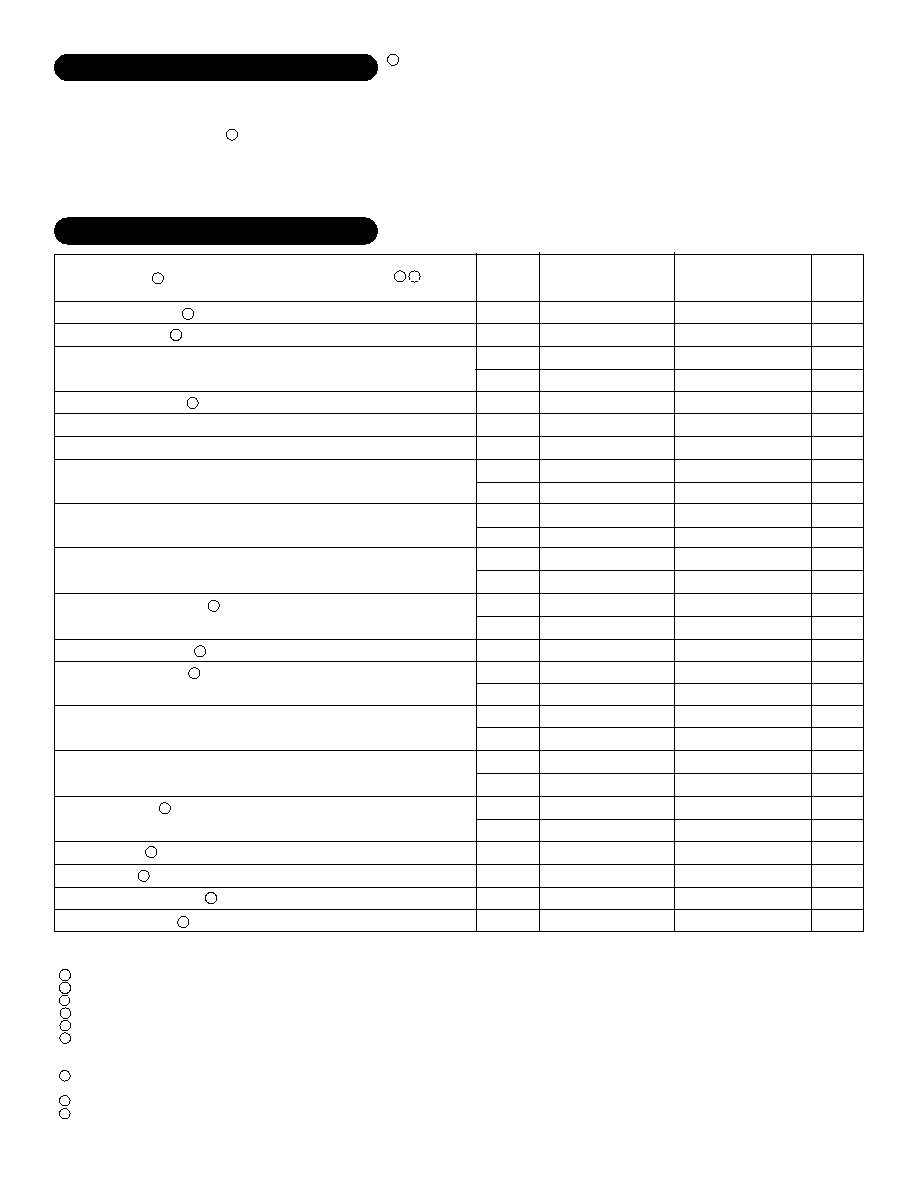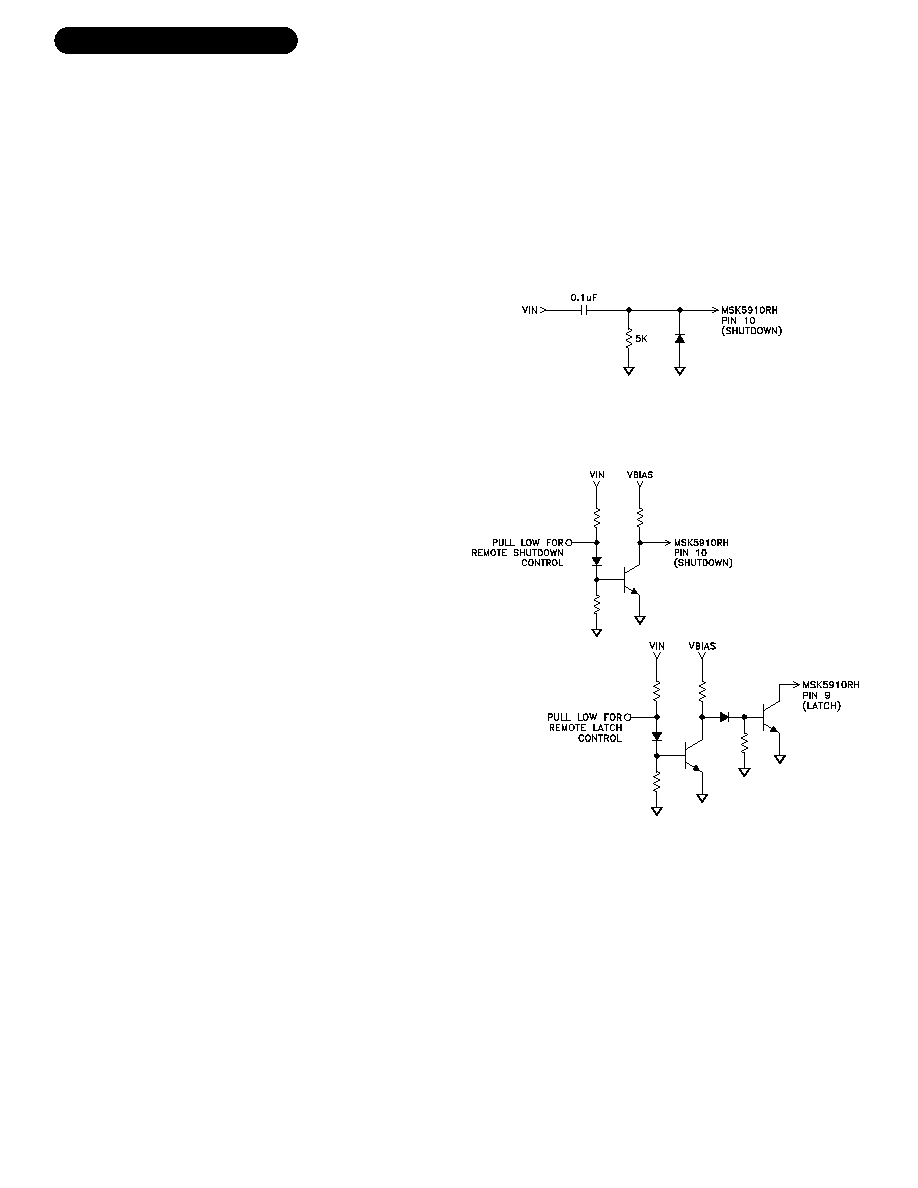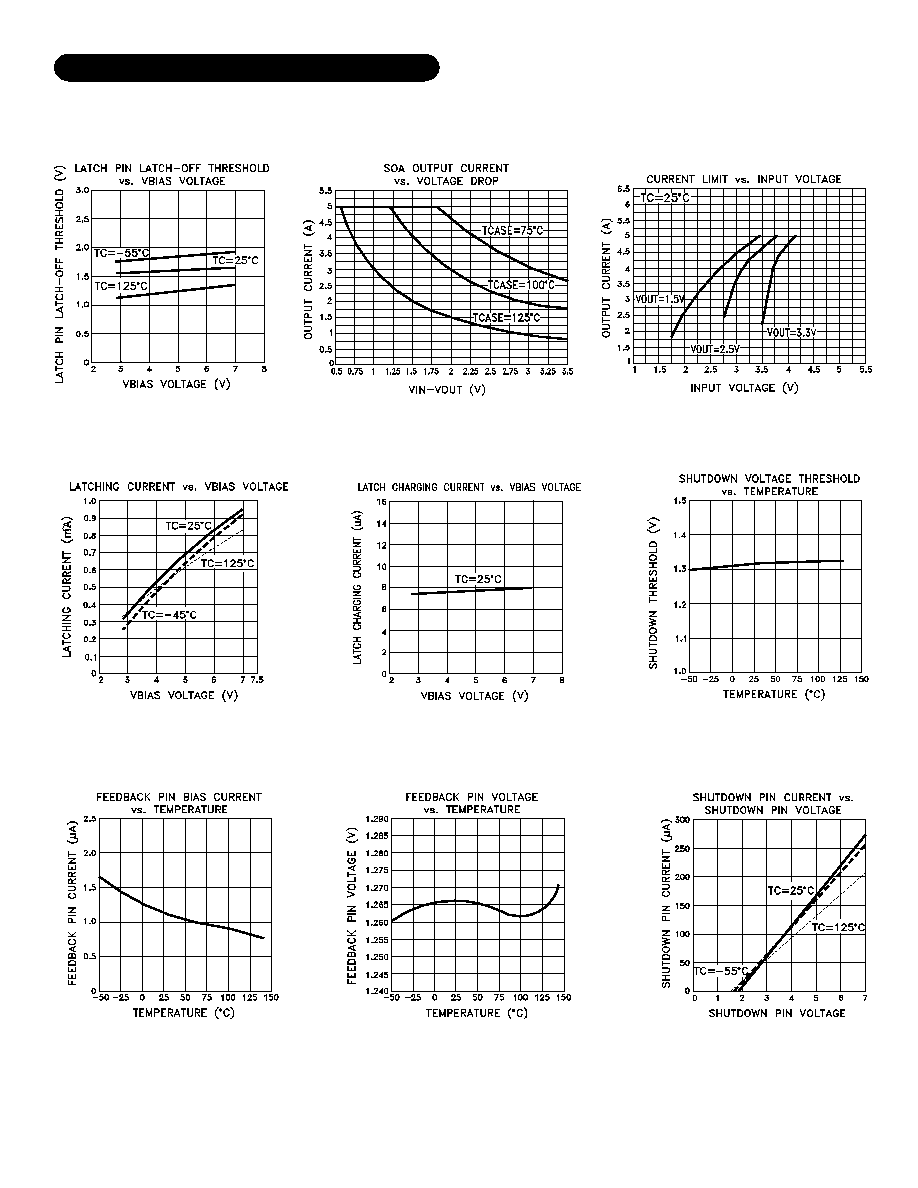
VOUTE
VOUTD
VOUTC
VOUTB
VOUTA
NC
GND2
GND2
GND2
FB
TYPICAL APPLICATIONS
4707 Dey Road Liverpool, N.Y. 13088
(315) 701-6751
MIL-PRF-38534 CERTIFIED
5910RH
M.S.KENNEDY CORP.
FEATURES:
Satellite System Power Supplies
Switching Power Supply Post Regulators
Constant Voltage/Current Regulators
Microprocessor Power Supplies
RAD TOLERANT ULTRA LOW
DROPOUT ADJUSTABLE
POSITIVE LINEAR REGULATOR
EQUIVALENT SCHEMATIC
TYPICAL APPLICATIONS
DESCRIPTION:
The MSK 5910RH is a rad tolerant adjustable linear regulator capable of delivering 5.0 amps of output current.
The typical dropout is only 0.11 volts at 1 amp. An external shutdown/reset function is ideal for power supply
sequencing. This device also has latching overload protection that requires no external current sense resistor. The
MSK 5910RH is radiation tolerant and specifically designed for many space/satellite applications. The device is
packaged in a hermetically sealed 20 pin flatpack that can be lead formed for surface mount applications.
PIN-OUT INFORMATION
VINA
VINB
VINC
VIND
VINE
VBIAS
GND1
GND1
Latch
Shutdown
Total Dose Tested to 300K RAD
Ultra Low Dropout for Reduced Power Consumption
External Shutdown/Reset Function
Latching Overload Protection
Adjustable Output Using Two External Resistors
Output Current Limit
Surface Mount Package Available with Lead Forming
Low Input Voltage for Maximum Efficiency
Up to 5A Output Current
Available to DSCC SMD #5962-05220
1
2
3
4
5
6
7
8
9
10
Rev. I 3/06
1
20
19
18
17
16
15
14
13
12
11

Input Voltage Range
Input Bias Voltage
Feedback Voltage
Feedback Pin Current
Quiescent Current
Bias Current
Line Regulation
Load Regulation
Dropout Voltage
Minimum Output Current
Output Voltage Range
Output Current Limit
Shutdown Threshold
Shutdown Hysteresis
Ripple Rejection
Phase Margin
Gain Margin
Equivalent Noise Voltage
Thermal Resistance
Storage Temperature Range
Lead Temperature Range
(10 Seconds)
Power Dissipation
Junction Temperature
ABSOLUTE MAXIMUM RATINGS
10.0V
10.0V
5A
-55∞C to +125∞C
-40∞C to +85∞C
Bias Supply Voltage
Supply Voltage
Output Current
Case Operating Temperature Range
MSK5910K/H/E RH
MSK5910RH
-65∞C to +150∞C
300∞C
See SOA Curve
150∞C
1
2
3
4
5
6
7
8
9
T
ST
T
LD
P
D
T
C
+V
BIAS
+V
IN
I
OUT
T
C
Unless otherwise specified, V
BIAS
=V
IN
=5.0V, R1=1.62K, V
SHUTDOWN
=0V and I
OUT
=10mA. I
OUT
is subtracted from I
Q
measurement.
Guaranteed by design but not tested. Typical parameters are representative of actual device performance but are for reference only.
Industrial grade and "E" suffix devices shall be tested to subgroups 1 and 4 unless otherwise requested.
Military grade devices ("H" suffix) shall be 100% tested to subgroups 1,2,3 and 4.
Subgroup 5 and 6 testing available upon request.
Subgroup 1,4 T
C
=+25∞C
Subgroup 2,5 T
C
=+125∞C
Subgroup 3,6 T
A
=-55∞C
Output current limit is tested with a low duty cycle pulse to minimize junction heating and is dependent on the values of V
IN
, V
OUT
and case
temperature. See Typical Performance Curves.
Contact factory for post radiation limits.
Continuous operation at or above absolute maximum ratings may adversely effect the device performance and/or life cycle.
NOTES:
Group A
Subgroup
1,2,3
1,2,3
1
2,3
1,2,3
1,2,3
1,2,3
1
2,3
1
2,3
1
2,3
1
2,3
-
1
2,3
1
2,3
1
2,3
4
5,6
4,5,6
4,5,6
4,5,6
-
10mA
I
OUT
1.0A
V
BIAS
V
IN
I
OUT
=
1.0A R1=187
V
FB
=1.265V 10mA
I
OUT
1.0A
I
IN
+I
BIAS,
V
BIAS
=V
IN
=7.5V Not including I
OUT
V
BIAS
=7.5V
I
OUT
=10mA 2.8V
V
IN
7.5V
R1=187
10mA
I
OUT
1.0A
R1=976
Delta FB=1% I
OUT
=1.0A
2.8V
V
IN
7.5V
R1=187
V
IN
=7.5V
V
IN
=2.5V V
OUT
=1.5V
V
OUT
0.2V (OFF)
V
OUT
=Nominal (ON)
Difference between voltage
threshold of V
SDI
(ON) and V
SDI
(OFF)
f=1KHz to 10KHz
10mA
I
OUT
1.0A 1.0V=V
IN
-V
OUT
I
OUT
=450mA
I
OUT
=45OmA
Referred to Feedback Pin
Junction to Case @ 125∞C Output Device
Typ.
-
5.0
1.265
-
-
14
2
±0.01
-
±0.06
-
0.11
0.14
8
9
-
3.6
-
1.3
1.3
0.02
0.03
-
-
80
30
-
7.3
Test Conditions
Max.
7.5
7.5
1.305
1.305
5.0
20
4
±0.50
±0.50
±0.80
±0.80
0.40
0.40
10
10
7.0
4.0
-
1.6
1.6
0.2
0.2
-
-
-
-
50
8.4
Min.
2.0
2.8
1.225
1.225
0
-
-
-
-
-
-
-
-
-
-
1.5
3.2
3.0
1.0
1.0
-
-
20
20
30
10
-
-
Min.
2.0
2.8
1.202
-
0
-
-
-
-
-
-
-
-
-
-
1.5
3.2
-
1.0
-
-
-
20
-
30
10
-
-
Max.
7.5
7.5
1.328
-
5.0
20
4
±0.60
-
±1.0
-
0.45
-
10
-
7.0
4.0
-
1.6
-
0.2
-
-
-
-
-
50
9.0
Typ.
-
5.0
1.265
-
-
14
2
0.01
-
0.06
-
0.11
-
8
-
-
3.6
-
1.3
-
0.02
-
-
-
80
30
-
7.3
V
V
V
V
µA
mA
mA
%V
OUT
%V
OUT
%V
OUT
%V
OUT
V
V
mA
mA
V
A
A
V
V
V
V
dB
dB
degrees
dB
µV
RMS
∞C/W
MSK5910K/H/E
MSK5910
Parameter
ELECTRICAL SPECIFICATIONS
2
Rev. I 3/06
Units
1
8
2
2
2
7
2
2
2
2
2
2
8
2
7
9

APPLICATION NOTES
VIN A,B,C,D,E - These pins provide the input power connection
to the MSK 5910RH. This is the supply that will be regulated to
the output. All five pins must be connected for proper opera-
tion.
VBIAS - This pin provides power to all internal circuitry including
bias, start-up, thermal limit and overcurrent latch. VBIAS volt-
age range is 2.8V to 7.5V. VBIAS should be kept greater than or
equal to VIN.
GND1 - Internally connected to input ground, these pins should
be connected externally by the user to the circuit ground and
the GND2 pins.
LATCH - The MSK 5910RH has a timed latch-off circuit which
provides overcurrent protection. An overcurrent or output short
condition will saturate the internal drive transistor. The time-out
latch will then be triggered and turn off the regulator. The time-
out period is determined by an external capacitor connected
between the latch and GND pins. Once the overcurrent condi-
tion is removed, the latch can be reset by pulling the SHUT-
DOWN pin high, grounding the LATCH pin or cycling power off,
then on. Holding the latch pin low disables current limiting. Un-
der normal conditions, the voltage at the LATCH pin is zero.
When the device is latched off, the voltage at the LATCH pin
will be 1.6V at 25∞C.
SHUTDOWN - There are two functions to the SHUTDOWN pin.
It may be used to disable the output voltage or to reset the
LATCH pin. To activate the shutdown/reset functions the user
must apply a voltage greater than 1.3V to the SHUTDOWN pin.
The output voltage will turn on when the SHUTDOWN pin is
pulled below the threshold voltage. If the SHUTDOWN pin is not
used, it should be connected to ground.
FB - The FB pin is the inverting input of the internal error ampli-
fier. The non-inverting input is connected to an internal 1.265V
reference. This error amplifier controls the drive to the output
transistor to force the FB pin to 1.265V. An external resistor
divider is connected to the output, FB pin and ground to set the
output voltage.
GND2 - Internally connected to output ground, these pins should
be connected externally by the user to the circuit ground and
the GND1 pins.
VOUT A,B,C,D,E - These are the output pins for the device. All
five pins must be connected for proper operation.
Typically, large bulk capacitance is required at the output of a
linear regulator to maintain good load transient response. How-
ever, with the MSK 5910RH this is not the case. A 47µF surface
mount tantalum capacitor in parallel with a 0.1µF ceramic ca-
pacitor from the output to ground should suffice under most
conditions. If the user finds that tighter voltage regulation is
needed during output transients, more capacitance may be added.
If more capacitance is added to the output, the bandwidth may
suffer.
As previously mentioned, the LATCH pin provides over cur-
rent/output short circuit protection with a timed latch-off circuit.
The latch off time out is determined with an external capacitor
connected from the LATCH pin to ground. The time-out period is
equal to the time it takes to charge this external capacitor from
0V to 1.6V. The latch charging current is provided by an internal
current source. This current is a function of bias voltage and
temperature (see latch charging current curve). For instance, at
25∞C, the latch charging current is 7.2µA at VBIAS=3V and
8µA at VBIAS=7V.
In the latch-off mode, some additional current will be drawn
from the bias supply. This additional latching current is also a
function of bias voltage and temperature (see latching current
curve).
The MSK 5910RH current limit function is directly affected by
the input and output voltages. Custom current limit is available;
contact the factory for more information.
3
Rev. I 3/06
POWER SUPPLY BYPASSING
To maximize transient response and minimize power supply
transients it is recommended that a 33µF minimum tantalum
capacitor is connected between VIN and ground. A 0.1µF ce-
ramic capacitor should also be used for high frequency bypass-
ing.
START UP OPTIONS
The MSK 5910RH starts up and begins regulating immediately
when VBIAS and VIN are applied simultaneously. Applying VBIAS
before VIN starts the MSK 5910RH up in a disabled or latched
state. When starting in a latched state the device output can be
enabled either by pulling the latch pin low to drain the latch ca-
pacitor or pulsing the shutdown pin high. The shutdown pulse
duration is partially dependent upon the size of the latch capacitor
and should be characterized for each application; 30uS is typically
adequate for a 1uF latch capacitor at 25∞C. A momentary high
pulse on the shutdown pin can be achieved using the RC circuit
below if VIN rises rapidly. The resistor and capacitor must be
selected based on the required pulse duration, the rise character-
istic of VIN and the shutdown pin threshold (see shutdown pin
threshold and current curves).
The shutdown pin can be held high and pulled low after VIN comes
up or the latch pin held low and released after VIN comes up to
ensure automatic startup when applying VBIAS before VIN. Ei-
ther of the basic circuits below can be adapted to a variety of
applications for automatic start up when VBIAS rises before VIN.
PIN FUNCTIONS
OUTPUT CAPACITOR SELECTION
OVERCURRENT LATCH-OFF/LATCH PIN CAPACITOR
SELECTION

APPLICATION NOTES CONT.
4
Rev. I 3/06
HEAT SINK SELECTION
To select a heat sink for the MSK 5910RH, the follow-
ing formula for convective heat flow may be used.
Governing Equation:
T
J
=
P
D
X (R
JC
+ R
CS
+ R
SA
) + T
A
Where
T
J
= Junction Temperature
P
D
= Total Power Dissipation
R
JC
= Junction to Case Thermal Resistance
R
CS
= Case to Heat Sink Thermal Resistance
R
SA
= Heat Sink to Ambient Thermal Resistance
T
A
= Ambient Temperature
Power Dissipation=(V
IN
-V
OUT
) x I
OUT
Next, the user must select a maximum junction tem-
perature. The absolute maximum allowable junction tem-
perature is 150∞C. The equation may now be rearranged
to solve for the required heat sink to ambient thermal
resistance (R
SA
).
Example:
An MSK 5910RH is connected for V
IN
=+5V and
V
OUT
=+3.3V. I
OUT
is a continuous 1A DC level. The
ambient temperature is +25∞C. The maximum desired
junction temperature is +125∞C.
R
JC
=8.5∞C/W and R
CS
=0.15∞C/W for most thermal
greases
Power Dissipation=(5V-3.3V) x (1A)
=1.7Watts
Solve for R
SA:
125∞C - 25∞C
1.7W
= 50.2∞C/W
In this example, a heat sink with a thermal resistance
of no more than 50∞C/W must be used to maintain a
junction temperature of no more than 125∞C.
V
OUT
=1.265(1+R1/R2)
OUTPUT VOLTAGE SELECTION
As noted in the above typical applications circuit,
the formula for output voltage selection is
A good starting point for this output voltage selection is
to set R2=1K. By rearranging the formula it is simple to
calculate the final R1 value.
Table 1 below lists some of the most probable resistor
combinations based on industry standard usage.
TABLE 1
R1
R2
1+
V
OUT
=1.265
V
OUT
1.265
-1
R1=R2
1.5
1.8
2.0
2.5
2.8
3.3
4.0
5.0
R2
(
)
1K
1K
1K
1K
1K
1K
1K
1K
R1 (nearest 1%)
(
)
187
422
576
976
1.21K
1.62K
2.15K
2.94K
R
SA
= -8.5∞C/W - 0.15∞C/W
OUTPUT
VOLTAGE
(V)
TYPICAL APPLICATIONS CIRCUIT
THERMAL LIMITING
The MSK 5910RH control circuitry has a thermal shut-
down temperature of approximately 150∞C. This ther-
mal shutdown can be used as a protection feature, but
for continuous operation, the junction temperature of the
pass transistor must be maintained below 150∞C. Proper
heat sink selection is essential to maintain these condi-
tions.

TYPICAL PERFORMANCE CURVES
Rev. I 3/06
5




